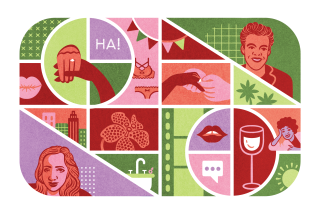On Valentine’s Day, Anita Loos’ diamonds are a girl’s best friend
How is it possible that, until this week, I had never read Anita Loos’ “Gentlemen Prefer Blondes”? Certainly, I’ve seen the Howard Hawks film. The book, however, managed to elude me -- until a new edition (W.W. Norton, $13.95) featuring a nuanced introduction by Jenny McPhee landed on my desk, just in time for Valentine’s Day.
If you’re among the uninitiated, as I was, “Gentlemen Prefer Blondes” is a perfect read for this most saccharine of holidays: a cynical knife blade of a novel, barely 130 pages, that puts the lie to romance. “[K]issing your hand may make you feel very very good,” the narrator, a young woman named Lorelei Lee, tells us, “but a diamond and safire bracelet lasts forever.”
This, of course, is the origin of the famous Marilyn Monroe line: “A kiss on the hand may be quite continental / but diamonds are a girl’s best friend.” Monroe played Lorelei in the 1953 movie, a performance in which, McPhee observes, she “seemed to have ascertained that the world was one big bastion of hypocrisy, especially when it came to women, so she put a new spin on an old adage: if you can’t beat ’em, make ’em pay, pay, pay.”
The same might be said of Loos’ novel, which became a huge bestseller upon its publication in 1925. Originally serialized in Harper’s Bazaar, it drew the attention of H.L. Mencken and Aldous Huxley; Edith Wharton called it “the great American novel -- at last.”
Loos writes the book as Lorelei’s diary, complete with misspellings, malapropisms and catastrophic grammar (“a girl like I”). But lest this make us think her narrator is vapid, that voice becomes one of the novel’s most subversive charms.
Lorelei, after all, knows what men want, and how to get what she wants from them. Upon her arrival in Paris, where a rich businessman has sent her, she notes, with no small edge of triumph, that the pleasure of meeting women such as “the Dolly sisters, and Pearl White and Maybelle Gilman Corey, and Mrs. Nash” is “beyond worlds ... [b]ecause when a girl looks at Mrs. Nash and realizes what Mrs. Nash has got out of gentlemen, it really makes a girl hold her breath.”
On the one hand, this is farce pure and simple, and part of the fun is to watch Lorelei and her tough-talking friend Dorothy take the air out of society’s pretensions, which, then as now, were ripe for satire. But even more, the power of the novel is Lorelei’s: her unwillingness to play the victim and her canny manipulation of those who would manipulate her.
In Vienna, she meets Sigmund Freud (“Dr. Froyd,” she calls him), who “seemed very intreeged at a girl who always seemed to do what she wanted to do.” His suggestion at the end of their session? “[T]hat all I needed was to cultivate a few inhibitions and get some sleep.”
Here, Loos highlights the novel’s method: to parody the proceedings while also offering an opposing point of view. Lorelei is unconflicted because she has no inhibitions, because she always does just what she wants to do.
That this is Panglossian goes without saying; for Lorelei, “everything always turns out for the best.” And yet, it also illustrates the difference between the new world and the old, America and Europe, the 20th century and the 19th. “I’m beginning to think,” she says late in the novel, “that family life is only fit for those who can stand it.” Implicit in such a statement is that she has other fish to fry.
Lorelei, then, is nothing if not modern, a woman of her generation. “In her inimitable first-person narrative in diary form,” McPhee writes, “Lorelei skewers every possible power structure: politics, religion, class, society, culture, consumerism, psychoanalysis, Hollywood, even language itself.”
ALSO:
The art of the guilty pleasure
More to Read
Sign up for our Book Club newsletter
Get the latest news, events and more from the Los Angeles Times Book Club, and help us get L.A. reading and talking.
You may occasionally receive promotional content from the Los Angeles Times.








